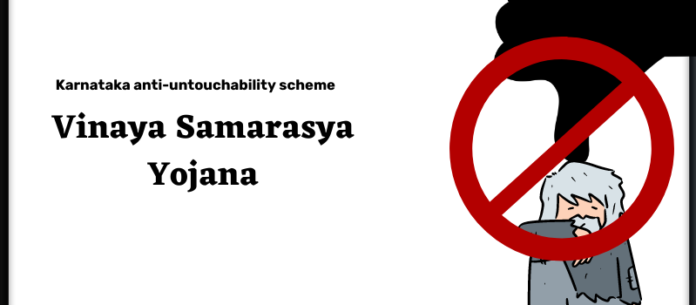The government of Karnataka has introduced Vanaya Samarasya Yojana, an awareness programme. Its aim is to educate people about untouchability and eradicate it from Gram Panchayats located across the state.
More about Vinaya Samarasya Yojana
- Karnataka social welfare minister will launch the Vinaya Samarasya Yojana on April 14, on the occasion of Ambedkar Jayanti.
- The scheme was included in the Karnataka Budget for 2022-23 with an aim to eradicate untouchability in the state.
- This scheme is named after a 3 year old Dalit boy who entered a temple in Miyapur village in Koppal district in Karnataka to escape the rain.
- The dailt boy’s family was forced to escape from the village after the social boycott started by the dominant Ganiga community of the village. Miyapur is a village with population of 1,500 people, dominated by Ganigas, where only 91 villagers are from Dalit community.
Untouchability and Caste System in India
India is unique in the way it has a long and convoluted history of class and caste systems nested within each other, which were also intertwined with religion. To write about any one of these topics alone would require a lot of research, but to discuss them all at once would be unenvious for many. However, here we will discuss caste system in India today, brief history of untouchability and more.
Caste System in India today
Caste system is still influential today in India, but it is not how special it was in the past. It hinders people from surpassing current income and wealth levels, as each caste has certain exclusions that prevent them from improving themselves. Caste system tends to keep those at the bottom of society in poverty. However, there are still those who believe that an individual’s rise up the caste system could be based off their own personal merits like hard work and perseverance.
There have been countless wars fought over the issue of the caste system, both in its original form and in a more modernized, advanced one. The conflict typically surrounds who has the rights and power to sink them into lower castes – historically due Westerners and educated Indians. Recently, social economic problems such as unemployment and family disintegration have led to more attention on the existence of this division within India. Over time, an alternative to the traditional caste system has emerged- namely a caste-free community entirely different from reservation systems that lead many people to remain outside these hierarchies entirely.
A Brief look at the history of untouchability
- In Varna based division of the society was not rigid, it was based on the type of work people do: brahmana, kshatriya, vaishya and Shudra, and it did not had any exclusions for population composed of slaves, outcastes etc.
- At its inception the Caste System was not very very rigid, as noone was decided to have a caste since birth. But after the Post-Vedic Period, the caste system become a rigid institution.
- Untouchability is the belief that a particular group of people should not be exposed to human interaction for their own protection. Untouchability had roots in the Hindu caste system, but it was not until around the beginning of the 19th century that untouchability began to be codified as a practice.
- The idea was that societal elites should be separate, in order to maintain their social and caste distinction. In the early 19th century, untouchability pervaded all Hindu communities. Untouchables had their identities underwritten by a fear of contamination and impurity.
- The upholders of the practice were those at the top of the caste system – Brahmins, some weavers and most notably those managing temple activities.
- Sanskrit names are monikers denoting different categories of persons in Hinduism. Harijans , was the name given to the people considered untouchables.
The Current Status
As reported by Indian Express, in the state of Karnataka, the conviction rate at present in the case of atrocities done against the Scheduled Castes and Tribes account for 7 percent. It has been reported that a total of 23,095 cases of atrocities done against SC/ST people are registered in Karnataka since 2019, out of which 19,057 cases are still in pending at various courts.











































